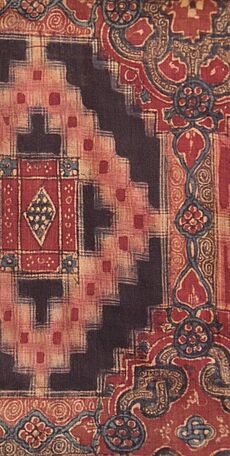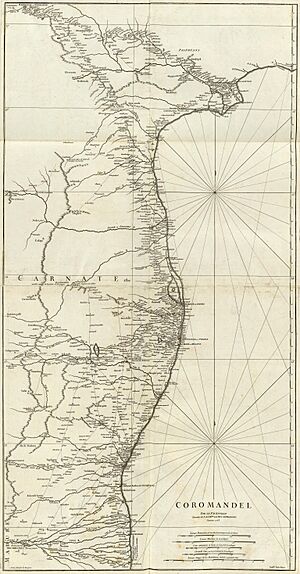Coromandel Coast facts for kids
The Coromandel Coast is a long coastal area in southeastern India. It stretches for about 22,800 square kilometers. This region is bordered by the Utkal Plains to the north and the Bay of Bengal to the east. To the south is the Kaveri river delta, and to the west are the Eastern Ghats. These are a chain of low, flat-topped hills. The coast itself is mostly flat, about 80 meters above sea level.
The name Coromandel comes from the Tamil language. The land of the ancient Chola dynasty was called Cholamandalam. This means "the realm of the Cholas." Over time, this name changed to Coromandel.
Contents
What's in a Name?
The name Coromandel has an interesting history. As mentioned, it likely comes from Cholamandalam in Tamil. This means "the land of the Chola kings." The Portuguese explorers then used a similar name.
Another idea is that the name comes from Karai mandalam. This means "the realm of the Shores." It describes the coastal area well.
Some people believe the name came from a mistake. The first Dutch ship to reach India stopped at a village called Karimanal. This village is north of Pulicat. Sailors on the ship might have mispronounced it as 'Corimondal'. This name then stuck.
An Italian explorer, Ludovico di Varthema, might have first used the name Coromandel in 1510. The Portuguese then put it on their maps. But it was the Dutch who started serious trading in the area.
Plants and Nature
The Coromandel Coast is home to special forests. These are called the East Deccan dry evergreen forests. They grow in a narrow strip along the coast. Unlike many dry forests in India, the trees here keep their leaves all year. Their leaves are thick and leathery.
The coast also has many mangrove forests. These grow in low-lying areas and river deltas. Mangroves are important for the environment. Several important wetlands are also found here. These include Kaliveli Lake and Pulicat Lake. These wetlands are home to thousands of birds. Many birds migrate here, while others live here all the time.
A Look at History

By the late 1530s, European countries started setting up trading posts. The Portuguese had three settlements. These were at Nagapattinam, São Tomé de Meliapore, and Pulicat.
In the 1600s and 1700s, European powers competed for control. They all wanted to control trade with India. The British set up posts at Fort St George (Madras) and Masulipatnam. The Dutch were at Pulicat, Sadras, and Covelong. The French had posts at Pondicherry, Karaikal, and Nizampatnam. The Danish were at Dansborg in Tharangambadi.
Eventually, the British gained the most control. However, France kept small areas like Pondichéry and Karaikal until 1954.
Chinese lacquer goods became known as "Coromandel" goods. This happened in the 1700s. Many Chinese products were shipped from the Coromandel ports. These goods included boxes, screens, and chests.
On December 26, 2004, a huge natural disaster happened. A powerful earthquake struck off the coast of Sumatra (Indonesia). This caused a massive tsunami. The tsunami hit the Coromandel Coast very hard. It killed many people and destroyed many coastal towns. Over 220,000 people died around the Indian Ocean.
Where Else is the Name Used?
The name Coromandel is used in other places too.
- Four ships of the Royal Navy were named HMS Coromandel.
- The Coromandel Peninsula in New Zealand was named after one of these ships.
- The town of Coromandel, New Zealand was then named after the peninsula.
- Coromandel Valley, South Australia, and Coromandel East are suburbs in Australia. They got their names from a ship called Coromandel. This ship arrived in 1837 with 156 English settlers. Some sailors from the ship ran away. They hid in the hills of the Coromandel Valley region.
- In the Slovene language, there is an idiom. It is Indija Koromandija. This means a land of plenty or a promised land. It's a place where "Houses are bleached with cheese and covered with cake."
- Edward Lear started his funny poem The Yonghy Bonghy Bo with the line: On the Coast of Coromandel.
- The Coromandel Express is a famous train in India. This daily train travels along the east coast of India. It runs between Shalimar railway station in West Bengal and Chennai Central railway station in Tamil Nadu.
See also
- Malabar Coast
- Presidency of Coromandel and Bengal Settlements


